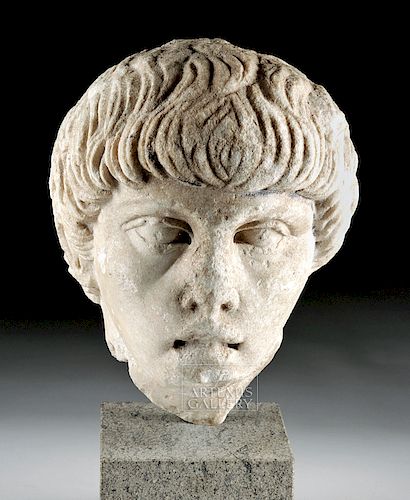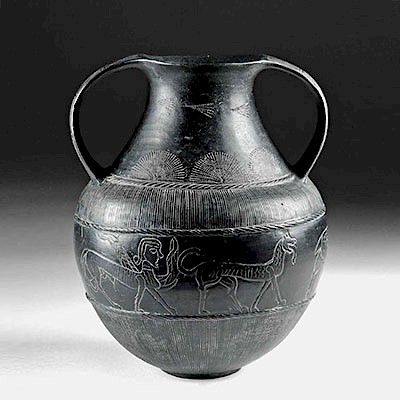Roman Marble Head of a Youthful Barbarian
Lot 73
About Seller
Artemis Fine Arts
686 S Taylor Ave, Ste 106
Louisville, CO 80027
United States
Selling antiquities, ancient and ethnographic art online since 1993, Artemis Gallery specializes in Classical Antiquities (Egyptian, Greek, Roman, Near Eastern), Asian, Pre-Columbian, African / Tribal / Oceanographic art. Our extensive inventory includes pottery, stone, metal, wood, glass and textil...Read more
Estimate:
$20,000 - $30,000
Absentee vs Live bid
Two ways to bid:
- Leave a max absentee bid and the platform will bid on your behalf up to your maximum bid during the live auction.
- Bid live during the auction and your bids will be submitted real-time to the auctioneer.
Bid Increments
| Price | Bid Increment |
|---|---|
| $0 | $25 |
| $300 | $50 |
| $1,000 | $100 |
| $2,000 | $250 |
| $5,000 | $500 |
| $10,000 | $1,000 |
| $20,000 | $2,500 |
| $50,000 | $5,000 |
| $100,000 | $10,000 |
| $200,000 | $20,000 |
About Auction
By Artemis Fine Arts
Mar 21, 2019
Set Reminder
2019-03-21 10:00:00
2019-03-21 10:00:00
America/New_York
Bidsquare
Bidsquare : Fine Ancient | Asian | Ethnographic Art
https://www.bidsquare.com/auctions/artemis-gallery/fine-ancient-asian-ethnographic-art-3967
Featuring classical antiquities, ancient and ethnographic art from cultures encompassing the globe, plus fine art. Egyptian, Greek, Roman, Etruscan, Near Eastern, Asian, Pre-Columbian, Native American, African / Tribal, Oceanic, Spanish Colonial, Russian, Fine Art, so much more! Artemis Fine Arts info@artemisfinearts.com
Featuring classical antiquities, ancient and ethnographic art from cultures encompassing the globe, plus fine art. Egyptian, Greek, Roman, Etruscan, Near Eastern, Asian, Pre-Columbian, Native American, African / Tribal, Oceanic, Spanish Colonial, Russian, Fine Art, so much more! Artemis Fine Arts info@artemisfinearts.com
- Lot Description
Roman, later Imperial Period, ca. 3rd century CE. A striking head of a young man with a mop of wavy, unruly hair - a signal that the artist is intending to show a barbarian, someone from outside of the Roman Empire. He has large eyes relative to his face, with heavy lids. Thin, gently arched eyebrows mark his brow line; his hair begins just above them, originating from the crown of his head. Despite his youth, the figure seems to have sunken cheeks and deep circles under his eyes, as if he is starving. He probably once had a short beard where his lost chin was; matted facial hair is also associated with the barbarian form in Roman sculpture. Size: 8.5" L x 8.25" W x 9" H (21.6 cm x 21 cm x 22.9 cm); 15.25" H (38.7 cm) on included custom stand.
Romans, like all citizens of hegemons, had a complicated relationship with the people who lived outside of the frontiers of their Empire. In art, they are depicted as wild, with unruly hair and fierce faces. The words used to describe them emphasize their otherness - their barbarism - in their customs, appearance, and clothing. For example, Romans depicted barbarians wearing trousers - necessary fashion for people engaged in riding and archery, like the people they would have come into contact with on the eastern borders of the Empire - and even banned the practice of wearing them in Rome itself in order to protect the toga. Captured barbarians became slaves in the earlier Roman period and in the later period barbarians were important parts of the Roman economy - providing markets and trade goods. As a result, there are two different types of artwork portraying these people: first, the type of Imperial propaganda showing captured enemies, and second, more quotidian scenes of everyday life where barbarians engage in economic and religious activity. This head, with its evocative expression and starved look, likely came from the former.
This head is very similar to one found in the excavated remains of the Mauritanian, Roman, and Berber city of Volubilis, modern day Morocco, now on display at the Fondation Nationale des Musees in Rabat, Morocco. Another head of a barbarian of similar form with the unruly hair and sunken cheeks is at the Seattle Art Museum: http://art.seattleartmuseum.org/objects/21479/portrait-head-of-a-barbarian-probably-a-dacian;jsessionid=C61599AF0CB68619BB048CBA9521B1BE?ctx=1471fa34-76fc-437f-9ce6-2da79d45a35b&idx=4
Provenance: private East Coast, USA collection; ex-William Froelich collection, New York, USA, collected in the 1970s; ex-German private collection, collected in the 1960s
All items legal to buy/sell under U.S. Statute covering cultural patrimony Code 2600, CHAPTER 14, and are guaranteed to be as described or your money back.
A Certificate of Authenticity will accompany all winning bids.
We ship worldwide and handle all shipping in-house for your convenience.
#143888Weathering on surface commensurate with age, especially visible on the eyes and mouth. Nose and part of chin are lost. Top of head has some wear but overall the hair is very nicely preserved. Deposits on surface.Condition
- Shipping Info
-
All shipping is handled in-house for your convenience. Your invoice from Artemis Gallery will include shipping calculation instructions. If in doubt, please inquire BEFORE bidding for estimated shipping costs for individual items.
-
- Buyer's Premium



 EUR
EUR CAD
CAD AUD
AUD GBP
GBP MXN
MXN HKD
HKD CNY
CNY MYR
MYR SEK
SEK SGD
SGD CHF
CHF THB
THB














